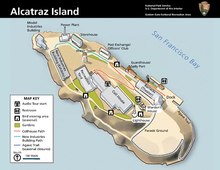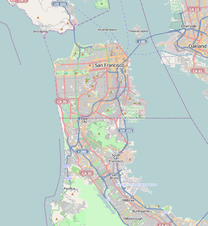Alcatraz Island
| Alcatraz Island | |
|---|---|
 Alcatraz Island from Tiburon Ferry | |
| Location | San Francisco Bay, California, US |
| Nearest city | San Francisco, California |
| Area | 22 acres (8.9 ha)[1] |
| Established | 1934 |
| Governing body | National Park Service |
Alcatraz Island (sometimes just called Alcatraz or The Rock) is a small island in the San Francisco Bay in California. It has been used for a lighthouse, a military fort, a military prison, a federal prison, and now a National Park.
The Alcatraz lighthouse, opened in 1854, was the first working lighthouse on the West Coast.
Name
[change | change source]The name "Alcatraz Island" comes from the island's original name in Spanish, Isla de los alcatraces (Island of the pelicans). Juan Manuel de Ayala, a Spanish explorer, named it that after noticing many pelicans roosting on the island.
History
[change | change source]Basic timeline
[change | change source]These are some of the major events in Alcatraz's history:[3][4][5]
- 10,000 to 20,000 years ago: Indigenous people arrive on Alcatraz Island
- 1775: Ayala becomes the first non-indigenous person to find and map Alcatraz
- 1850-1933: The United States Army uses the island as a military fort and military prison
- 1934-1963: A federal prison operates at Alcatraz
- 1963: After the prison closes, Alcatraz Island is basically abandoned
- 1969: The old prison becomes a museum
- 1969: Native American Indian protestors take over Alcatraz
- 1971: The federal government takes back control of the island
- 1972-Today: Alcatraz is a national park
Indigenous people
[change | change source]Indigenous people lived on Alcatraz Island for 10,000 to 20,000 years before Ayala arrived in 1775.
We do not know much about the indigenous people on the island, because they did not keep written records. Instead they used oral history, passing information verbally from generation to generation.[4] However, after European people arrived in California, the Indian population there decreased dramatically. As a result, a lot of oral history has been lost.[4]
The United States National Park Service writes:
Based on oral history it appears that Alcatraz was used as a place of isolation or ostracization for tribal members who had violated a tribal law or taboo[;] as a camping spot or an area for gathering foods, especially bird eggs and sea-life[; and] a hiding place for many Indians attempting to escape from the California Mission system.
19th century
[change | change source]In 1850, President Millard Filmore made Alcatraz a military reservation.
In the early 1850s, the United States Army built a citadel (fortress) on the island and installed many cannons. During the California Gold Rush (1848-1855), San Francisco grew quickly. The Army wanted to protect the entrance to the San Francisco Bay. They made Alcatraz the most heavily fortified military site on the West Coast.[3] However, it never fired its guns in battle.[3]

The Army began housing military prisoners on Alcatraz in the late 1850s. During the American Civil War (1861-1865), they imprisoned Confederate soldiers there.
Alcatraz became less important for defense. In 1909, the Army tore down the Citadel. For the next two years, military prisoners on the island built a new prison there. It was a "disciplinary barracks" for the U.S. Army soldiers. This building was later nicknamed "The Rock.
Alcatraz Federal Prison (1934-1963)
[change | change source]In 1933, the federal government gave control of Alcatraz to the Department of Justice to use as a federal prison. According to today's Bureau of Prisons:[3]
The Federal Government had decided to open a maximum-security, minimum-privilege [prison] to deal with the most incorrigible inmates in Federal prisons, and to show the law-abiding public that the Federal Government was serious about stopping the rampant crime of the 1920s and 1930s.
Escape was supposed to be impossible because the prison was on an island and surrounded by very cold waters with dangerous currents and sharks.
The prison opened in August 1934. Over the next 32 years, it became the most famous prison in American history.

Native American occupations (1964-1971)
[change | change source]Native American Indian protestors took over Alcatraz Island three times, using civil disobedience. They protesting for Native American rights, and to make people realize that Native Americans were not treated equally.[4]
The first two occupations (on March 9, 1964 and November 9, 1969). They did not last long.[4]
However, on November 20, 1969, Native Americans took over the island again. This time, they occupied the island for nineteen months. This drew a lot of attention to their cause. Federal agents finally took back control of the island on June 10, 1971.[4]
Famous prisoners
[change | change source]Most inmates at Alcatraz Prison were ordinary federal prisoners who refused to follow the rules at other prisons.[3] However, some very famous people were imprisoned at Alcatraz.
The Hopi Nineteen
[change | change source]From 1894-1895, the "Hopi Nineteen" were imprisoned at Alcatraz.[6] They were a group of Hopi men who lived on a reservation in Arizona. At the time, the U.S. government was requiring Native Americans to send their children to boarding schools, which were designed to assimilate them. When they refused to send their children thousands of miles away to these boarding schools, they were imprisoned and spent a year at Alcatraz.[6][7] This was controversial, and many people learned about the story through newspaper articles.
Prohibition-era gangsters
[change | change source]
Alcatraz's famous prisoners included many gangsters who did organized crime around the Prohibition era in the United States. Al "Scarface" Capone was sent to Alcatraz just a few weeks after it opened.[8] Capone was a Chicago mob boss who left Alcatraz in 1939.[9] George "Machine Gun" Kelly arrived less than a month after Capone. He was a Tennessee bootlegger and armed robber who committed a famous kidnapping. He left Alcatraz in 1951, transferring to Leavenworth federal prison.
Two members of the Barker-Karpis Gang were imprisoned at Alcatraz. The Gang operated for four years (from 1931-1935), which made it one of the longest-lived criminal gangs in the Great Depression era. Alvin Karpis, who co-led the gang, was in Alcatraz from 1936-1962. He was the first person the FBI ever named as "Public Enemy Number One," and was at Alcatraz longer than any other prisoner in history.[10] Ma Barker's son Arthur ("Doc") was also imprisoned at Alcatraz from 1935-1939. He was shot in 1939 while trying to escape.[10]
The 1940s - 1960s
[change | change source]Robert Stroud was imprisoned at Alcatraz from 1942-1959). He was a murderer nicknamed "the Birdman of Alcatraz". He left the prison in 1959. Birdman of Alcatraz, a 1962 movie starring Burt Lancaster, became very popular (though it changed many of the details of Stroud's story).[7][11]

Ten years after Stroud arrived, James "Bumpy" Johnson was sent to Alcatraz for trafficking heroin. Johnson was a Harlem drug kingpin.[7][9] After the Anglin brothers escaped Alcatraz in 1962, an inmate claimed that Johnson had helped them.[10] Johnson left Alcatraz in 1963.[10]
James "Whitey" Bulger, who later became an Irish Mob leader in Boston, was at Alcatraz from 1959-1962.[12]
Today
[change | change source]Today, Alcatraz is a national park that attracts many visitors. Millions of people come to the San Francisco Bay area to visit the old prison or hike the island.[5]
Some people have said that Alcatraz is haunted. Visitors often enjoy tales about ghosts on the prison grounds.
References
[change | change source]- ↑ "Alcatraz Island". Encyclopædia Britannica Online. Encyclopædia Britannica. 2009.
- ↑ "Alcatraz Island". Geographic Names Information System. United States Geological Survey.
- ↑ 3.0 3.1 3.2 3.3 3.4 "Historical Information: Alcatraz Origins". United States Bureau of Prisons. Retrieved 2024-09-28.
- ↑ 4.0 4.1 4.2 4.3 4.4 4.5 Johnson, Dr. Troy. "We Hold the Rock: The Alcatraz Indian Occupation". United States National Park Service. Retrieved September 28, 2024.
- ↑ 5.0 5.1 "Alcatraz Island". National Park Foundation. Retrieved 2024-09-28.
- ↑ 6.0 6.1 "Hopi Prisoners on the Rock". United States National Park Service. Retrieved 2024-09-28.
- ↑ 7.0 7.1 7.2 "7 Infamous Alcatraz Inmates". HISTORY. 2024-04-25. Retrieved 2024-09-28.
- ↑ "How Al Capone Spent His Time in Alcatraz". HISTORY. 2024-04-25. Retrieved 2024-09-28.
- ↑ 9.0 9.1 Riter, James (2024-08-16). "Chicago crime boss Al Capone transferred to Alcatraz 90 years ago this month". The Mob Museum. Retrieved 2024-09-28.
- ↑ 10.0 10.1 10.2 10.3 Riter, James (2024-08-16). "Chicago crime boss Al Capone transferred to Alcatraz 90 years ago this month". The Mob Museum. Retrieved 2024-09-28.
- ↑ See, e.g., Jolene Babyak, Bird Man: The Many Faces of Robert Stroud (Berkeley, California: Ariel Vamp Press, 1994, rev. 2011)
- ↑ Padnani, Amy; Seelye, Katharine Q. "Whitey Bulger: The Capture of a Legend". The New York Times. Retrieved 2024-09-28.
Other websites
[change | change source]![]() Media related to Alcatraz Island at Wikimedia Commons
Media related to Alcatraz Island at Wikimedia Commons


